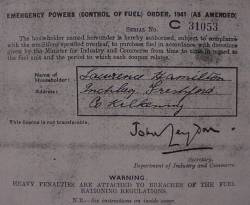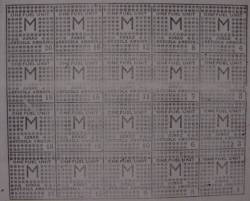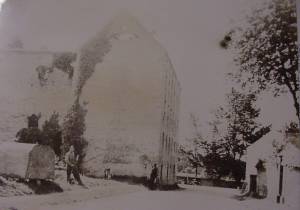

Rationing


During the Second World War, which was called "The Emergency" in Ireland, many different types of food and fuel were scarce. Anything that was imported was also very scarce because the ships that were used to import goods were being used for carrying war supplies. Shipping was very dangerous and many Irish ships were sunk even though Ireland was not in the war.
Oil, coal, rubber, tea, tobacco and fruit were just some of the things people had to do without.
The Government "rationed" food and fuel. This meant that every family could only buy a certain amount of food and fuel. Everyone had a ration book with coupons. The shopkeeper cut out the coupons when the family bought any food or fuel. If you did not have any coupons you could not buy any of the things that were rationed. You could not buy anything with used coupons either.
The two pages above are from a coupon book for fuel. The book was owned by Laurence Hamilton of Inchbeg, Freshford. Each coupon said: "One Fuel Unit", "Aonad Breosla Amháin".
These coupons were never used because the book was lost in Kilkenny
Post Office before it was sent out. It was only found a few years ago when the
post office was being renovated.
Source: Larry Hamilton.
Tobacco
Tobacco was very scarce during the Second World War. Sometimes people smoked beet pulp
War Crime
One man said that he had his tobacco stolen from his pocket in Ballyragget when he was receiving Holy Communion. He was kneeling at the altar rails. In those days people knelt down to receive Holy Communion. There was a cloth on the altar rails that you used to cover your hands.
You couldn't see anyone's hands with the cloth and that was why he didn't miss the tobacco from his pocket! He said it was one of the worst crimes of the whole war!
Tea
Tea was scarce during the war. people made tea from all sorts of things. some people grated carrots and then fried them to burn them. Then they dried them and made tea from the burned carrots.
Rubber
Rubber was also very scarce. It was hard to get tyres or tubes for bicycles. Geoff Brennan remembers buying a tube for his bicycle on the black market for 30/= (about €1.90) when the normal price was 4/6 (about 26c).
When bicycle tubes got old the rubber died in them and they were full of tiny pinholes. To seal these holes they put buttermilk in the tubes. They sucked the buttermilk up into the pump and pumped it into the tube. It worked fairly well but the smell was awful.
Gone Bananas
Fruit was scarce during the war. There was great excitement in 1944 in Jerry Delaney's shop. He had got in some bananas. One man went around Freshford shouting "There's bananas in Jerry's!"
The German Spy?
This is a photo of the German Spy (?) (left) who's name was "Vernon" (Werner?).
He arrived in the early 1940s beside the corn-grinding mill on the Durrow Road,
at Ballyragget. His house was the little tin hut (on left), that stood on four
concrete blocks and had wheels. In that hut "Vernon" lived and worked.
Source: Pat Farrell.
He was a very good watchmaker and he repaired watches and clocks for people in the area. There are still some clocks in the area that he repaired.
He was a very keen fisherman and would be up very early on summer mornings and could be seen along the bank of the Nore.
Local people believed that he was a German spy. One morning he had disappeared. The hut was still there but he was never seen again. The hut was left behind.
There was a story that he had been arrested in Castlecomer. When some German paratroopers were dropped in a field in Wexford and were caught, one of them had a list of people to contact. "Vernon's" name was on the list. And all of the people involved were brought to an internment camp in The Curragh, Co. Kildare.
Mark Keating remembers "Vernon" being a very nice man. Local people believed that he used his early morning fishing to tranmit weather reports and other information to Germany.
After he disappeared some locals used his hut when they stayed out all night hunting rabbits.
The other man in the picture is John Joe Archer. Also in the picture are the ruins of the old mill, which was burned down about 1905. People used to play handball against the high gable wall of the mill, on the far side, and once four people were caught and brought to court for playing handball on a public road. They were fined 2/6 (15c today).
Also in the picture (right) is Miss Lacey's grocery shop. There was a small bakery behind the shop and she sold freshly baked bread and cakes. Ballyragget school was then located here and the entrance can be seen in the photograph (extreme right). Mark Keating remembers that if pupils didn't have a lunch, they could get fresh currant buns in Lacey's shop for 1d.
We checked this story with the people in the Irish Army archives. They had no record of any spy being arrested in the area. There was one called Werner but there was no connection with Kilkenny and they didn't think it could have been the same person.
Was he just an innocent "German clockwinder"?
Snaring Rabbits
Mick Grace and Jack Hamilton told us that you could make great money during the war years, snaring rabbits and selling them to dealers. Some of the rabbits were sold in shops and others exported to England. A rabbit was worth 1/=. The snares were set at night and checked in the morning. Often before you started snaring you would kill the cats because the cats would eat the rabbits in the snares.
Sometimes on Sundays they hunted rabbits with dogs. The dogs would often break a rabbit's back when they caught it. A rabbit with a broken back was worth nothing. So they put a bicycle spoke up through the rabbit to try and straighten it and to hide it's broken back.
Sometimes too, dogs would tear a rabbit apart. Rather than lose the 1/=, they would sew the two parts of the rabbit together. The rabbit would then be washed in Lux soap and its fur brushed to hide the stitching. The rabbit was then hung out by its ears to dry. When they were selling rabbits they tied their hind legs together and hung them on a long stick. They always put the best looking rabbits on the outside and the damaged rabbits on the inside. Sometimes if they had a very thin rabbit, they would put a baby turnip into its chest to make it look plump.
The rabbits were bought in Stapleton's Shop, Ballyragget; Delaney's Shop, Lisdowney; Tommy "Record" Dowling in Ballyragget. A van would call to these shops to collect the rabbits to take them to England. By the end of the war the price of a rabbit had gone from 1/= to 2/=.